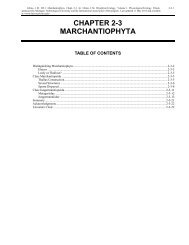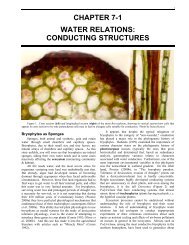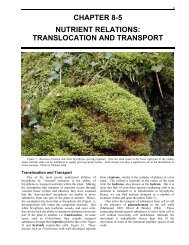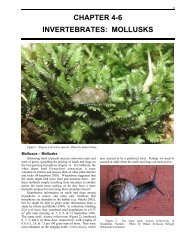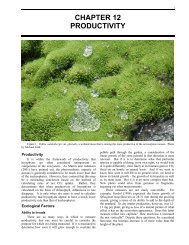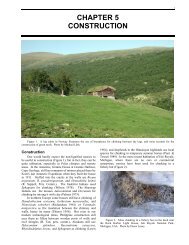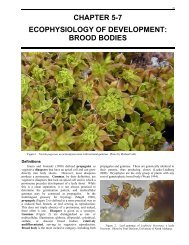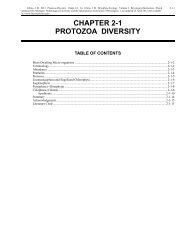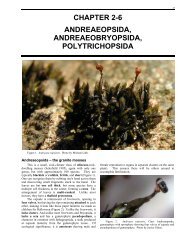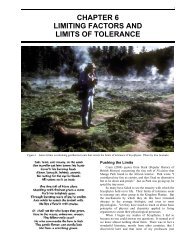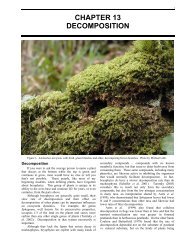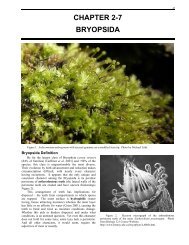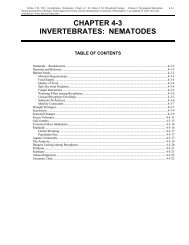Chapter 4-5 Invertebrates Rotifers - Bryophyte Ecology - Michigan ...
Chapter 4-5 Invertebrates Rotifers - Bryophyte Ecology - Michigan ...
Chapter 4-5 Invertebrates Rotifers - Bryophyte Ecology - Michigan ...
Create successful ePaper yourself
Turn your PDF publications into a flip-book with our unique Google optimized e-Paper software.
4-5-10 <strong>Chapter</strong> 4-5: <strong>Invertebrates</strong>: <strong>Rotifers</strong>Food<strong>Rotifers</strong> obtain their food by rotating cilia in thecorona that directs the food into the mouth. This enablesthem to eat small particles of organic matter, bacteria,algae, protozoa, and even other rotifers (Wikipedia 2012b).[These same cilia can be used for swimming (Fontaneto &Ricci 2004)]. The food is directed to the mouth and themastax (Figure 2), the latter consisting of the trophus andits musculature. This menu usually consists of food itemsthat are up to 10 µm in size (Wikipedia 2012b). Thisability to filter such small particles from their environmentmakes them useful in maintaining clean water in aquaria.Clément et al. (1980) described the muscle structure andmethod of controlling the cilia to obtain food for Philodinaroseola and Brachionus calyciflorus and their ability toreject some foods.Figure 27. Asplanchna sp. overfed on Keratella sp. Thislarge rotifer died after eating a large quantity of the smallerKeratella (van Egmond 2003). Photo by Wim van Egmond.Figure 26. Philodina rosea showing cilia that direct foodinto the mouth. Photo by Wim van Egmond.Role in the Food WebTiny animals usually have bigger animals that eatthem. The rotifers fall prey to copepods, fish, and Bryozoa,but small rotifers are also eaten by bigger rotifers (Wallaceet al. 2006). For example, members of the rotifer genusLecane are eaten by the rotifer Dicranophorus robustus(Jersabek et al. 2003), both known from bryophytes. Onthe other hand, when the Asplanchna ate too muchKertella, the Asplanchna died, possibly due to the spindein the Keratella (Figure 27).Most of the rotifer inhabitants of Sphagnum feed onsmall particles of food directed to them by their wheel cilia(Figure 28) (Hingley 1993). They mash their food with amodified pharynx called a mastax (Figure 29-Figure 30),thus modifying these in the ecosystem.But little rotifers have bigger enemies and may needrefuge, even among bryophytes. Some rotifers, especiallysessile rotifers, are easy prey for larger invertebrates. Forexample, Antarctic tardigrades appear to be importantpredators on rotifers (Sohlenius & Boström 2006). Somerotifers make tubes. Ptygura velata solves the problem ofbecoming dinner by making a tube from its own fecalpellets (Figure 31-Figure 32), where it withdraws fromdanger (Edmondson 1940).Figure 28. The two "wheels" on this moss-dwelling rotiferare in full motion. Photo by Andi Cairns.Figure 29. Colurella adriatica, showing location of themastax and other prominent features. This one is sitting on thegreen alga Spirogyra sp., but it sometimes occurs among mosses.Photo by Michel Verolet.<strong>Rotifers</strong> participate in a food web within the mosshabitat. Rotifer biomass on Sphagnum fallax decreased inresponse to experimentally added lead (Nguyen-Viet et al.



